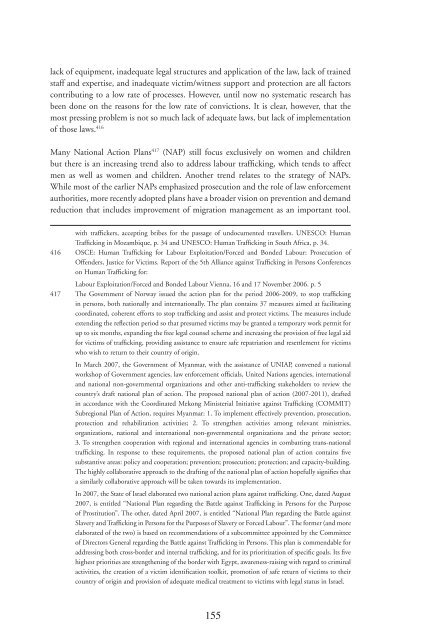Trafficking in human beings: human rights and ... - unesdoc - Unesco
Trafficking in human beings: human rights and ... - unesdoc - Unesco
Trafficking in human beings: human rights and ... - unesdoc - Unesco
You also want an ePaper? Increase the reach of your titles
YUMPU automatically turns print PDFs into web optimized ePapers that Google loves.
lack of equipment, <strong>in</strong>adequate legal structures <strong>and</strong> application of the law, lack of tra<strong>in</strong>ed<br />
staff <strong>and</strong> expertise, <strong>and</strong> <strong>in</strong>adequate victim/witness support <strong>and</strong> protection are all factors<br />
contribut<strong>in</strong>g to a low rate of processes. However, until now no systematic research has<br />
been done on the reasons for the low rate of convictions. It is clear, however, that the<br />
most press<strong>in</strong>g problem is not so much lack of adequate laws, but lack of implementation<br />
of those laws. 416<br />
Many National Action Plans 417 (NAP) still focus exclusively on women <strong>and</strong> children<br />
but there is an <strong>in</strong>creas<strong>in</strong>g trend also to address labour traffi ck<strong>in</strong>g, which tends to affect<br />
men as well as women <strong>and</strong> children. Another trend relates to the strategy of NAPs.<br />
While most of the earlier NAPs emphasized prosecution <strong>and</strong> the role of law enforcement<br />
authorities, more recently adopted plans have a broader vision on prevention <strong>and</strong> dem<strong>and</strong><br />
reduction that <strong>in</strong>cludes improvement of migration management as an important tool.<br />
with traffi ckers, accept<strong>in</strong>g bribes for the passage of undocumented travellers. UNESCO: Human<br />
Traffi ck<strong>in</strong>g <strong>in</strong> Mozambique, p. 34 <strong>and</strong> UNESCO: Human Traffi ck<strong>in</strong>g <strong>in</strong> South Africa, p. 34.<br />
416 OSCE: Human Traffi ck<strong>in</strong>g for Labour Exploitation/Forced <strong>and</strong> Bonded Labour: Prosecution of<br />
Offenders, Justice for Victims. Report of the 5th Alliance aga<strong>in</strong>st Traffi ck<strong>in</strong>g <strong>in</strong> Persons Conferences<br />
on Human Traffi ck<strong>in</strong>g for:<br />
Labour Exploitation/Forced <strong>and</strong> Bonded Labour Vienna, 16 <strong>and</strong> 17 November 2006. p. 5<br />
417 The Government of Norway issued the action plan for the period 2006-2009, to stop traffi ck<strong>in</strong>g<br />
<strong>in</strong> persons, both nationally <strong>and</strong> <strong>in</strong>ternationally. The plan conta<strong>in</strong>s 37 measures aimed at facilitat<strong>in</strong>g<br />
coord<strong>in</strong>ated, coherent efforts to stop traffi ck<strong>in</strong>g <strong>and</strong> assist <strong>and</strong> protect victims. The measures <strong>in</strong>clude<br />
extend<strong>in</strong>g the refl ection period so that presumed victims may be granted a temporary work permit for<br />
up to six months, exp<strong>and</strong><strong>in</strong>g the free legal counsel scheme <strong>and</strong> <strong>in</strong>creas<strong>in</strong>g the provision of free legal aid<br />
for victims of traffi ck<strong>in</strong>g, provid<strong>in</strong>g assistance to ensure safe repatriation <strong>and</strong> resettlement for victims<br />
who wish to return to their country of orig<strong>in</strong>.<br />
In March 2007, the Government of Myanmar, with the assistance of UNIAP, convened a national<br />
workshop of Government agencies, law enforcement offi cials, United Nations agencies, <strong>in</strong>ternational<br />
<strong>and</strong> national non-governmental organizations <strong>and</strong> other anti-traffi ck<strong>in</strong>g stakeholders to review the<br />
country’s draft national plan of action. The proposed national plan of action (2007-2011), drafted<br />
<strong>in</strong> accordance with the Coord<strong>in</strong>ated Mekong M<strong>in</strong>isterial Initiative aga<strong>in</strong>st Traffi ck<strong>in</strong>g (COMMIT)<br />
Subregional Plan of Action, requires Myanmar: 1. To implement effectively prevention, prosecution,<br />
protection <strong>and</strong> rehabilitation activities; 2. To strengthen activities among relevant m<strong>in</strong>istries,<br />
organizations, national <strong>and</strong> <strong>in</strong>ternational non-governmental organizations <strong>and</strong> the private sector;<br />
3. To strengthen cooperation with regional <strong>and</strong> <strong>in</strong>ternational agencies <strong>in</strong> combatt<strong>in</strong>g trans-national<br />
traffi ck<strong>in</strong>g. In response to these requirements, the proposed national plan of action conta<strong>in</strong>s fi ve<br />
substantive areas: policy <strong>and</strong> cooperation; prevention; prosecution; protection; <strong>and</strong> capacity-build<strong>in</strong>g.<br />
The highly collaborative approach to the draft<strong>in</strong>g of the national plan of action hopefully signifi es that<br />
a similarly collaborative approach will be taken towards its implementation.<br />
In 2007, the State of Israel elaborated two national action plans aga<strong>in</strong>st traffi ck<strong>in</strong>g. One, dated August<br />
2007, is entitled “National Plan regard<strong>in</strong>g the Battle aga<strong>in</strong>st Traffi ck<strong>in</strong>g <strong>in</strong> Persons for the Purpose<br />
of Prostitution”. The other, dated April 2007, is entitled “National Plan regard<strong>in</strong>g the Battle aga<strong>in</strong>st<br />
Slavery <strong>and</strong> Traffi ck<strong>in</strong>g <strong>in</strong> Persons for the Purposes of Slavery or Forced Labour”. The former (<strong>and</strong> more<br />
elaborated of the two) is based on recommendations of a subcommittee appo<strong>in</strong>ted by the Committee<br />
of Directors General regard<strong>in</strong>g the Battle aga<strong>in</strong>st Traffi ck<strong>in</strong>g <strong>in</strong> Persons. This plan is commendable for<br />
address<strong>in</strong>g both cross-border <strong>and</strong> <strong>in</strong>ternal traffi ck<strong>in</strong>g, <strong>and</strong> for its prioritization of specifi c goals. Its fi ve<br />
highest priorities are strengthen<strong>in</strong>g of the border with Egypt, awareness-rais<strong>in</strong>g with regard to crim<strong>in</strong>al<br />
activities, the creation of a victim identifi cation toolkit, promotion of safe return of victims to their<br />
country of orig<strong>in</strong> <strong>and</strong> provision of adequate medical treatment to victims with legal status <strong>in</strong> Israel.<br />
155

















